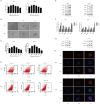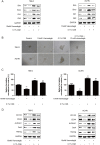Cigarette smoke stimulates the stemness of renal cancer stem cells via Sonic Hedgehog pathway
- PMID: 29540668
- PMCID: PMC5852977
- DOI: 10.1038/s41389-018-0029-7
Cigarette smoke stimulates the stemness of renal cancer stem cells via Sonic Hedgehog pathway
Abstract
Cancer stem cells (CSCs) are essentially responsible for tumor initiation, growth, progression, metastasis and recurrence, and cigarette smoke (CS) is closely involved in the occurrence and development of kidney cancer. However, the effect of CS on renal CSCs has not been elucidated yet. In the present study, tumorsphere formation assay was used to enrich renal CSCs from 786-O and ACHN cells. We illustrated that CS effectively promoted renal CSCs stemness by enhancing tumorsphere formation, increasing the expression of renal CSCs markers (CD133, CD44, ALDHA1, Oct4, and Nanog) and elevating CD133+ cell population. Moreover, our results showed that CS triggered the activation of Sonic Hedgehog (SHH) pathway, while inhibition of SHH pathway dampened the promotive effects of CS on renal CSCs. Finally, higher levels of renal CSCs markers and SHH pathway-related proteins were observed in kidney cancer tissues from smokers than non-smoking cancer tissues. Taken together, these results demonstrated the important role of SHH pathway in regulating CS-induced renal CSCs stemness augment. Findings from this study could provide new insight into the molecular mechanisms of CS-elicited stemness of renal CSCs.
Conflict of interest statement
The authors declare that they have no conflict of interest.
Figures





References
-
- Siegel RL, et al. Cancer statistics for Hispanics/Latinos, 2015. CA. 2015;65:457–480. - PubMed
-
- Mummery, C., Wilmut, S. I., Stolpe, A. V. D. & Roelen, B. A. J. Stem Cells in Cancer and Cancer Stem Cells 237–256 (Elsevier, 2011).
LinkOut - more resources
Full Text Sources
Other Literature Sources
Research Materials
Miscellaneous

